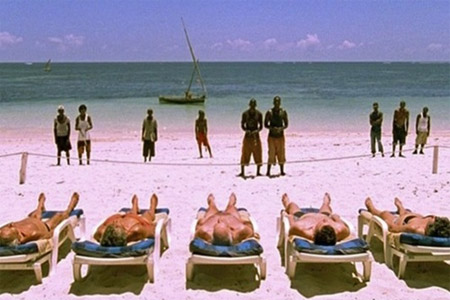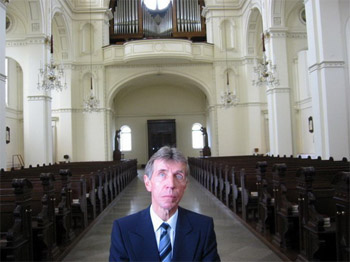Ulrich Seidl has finished at least 16 projects since 1980, and he could be described in a variety of ways: as a director, producer, screenwriter. But his own web site offers a different approach to elaborating on his career: with epithets. “Voyeur,” “misanthrope,” “cynic,” it reads. Successive nouns flash under Seidl’s logo, weirdly reminiscent of an infinity sign, as the descriptive monikers continue: “social pornographer,” “blackguard,” “provocateur.” It is, of course, self-conscious play with the common, and often superficial, interpretations of Seidl’s art that have been thrown in the director’s face through the years. Since the time Seidl started studying film in his mid-twenties, he hasn’t stopped raising controversy, first among his professors, later with film critics and the public. He enters competition at the Cannes International Film Festival with another film sure to raise dissent: Paradies: Liebe, a film about European sex tourism in Kenya—with women doing the buying.His first short, One Forty (1980), split lecturers at the Vienna Film Academy, where he studied. “I wanted to make a film about a dwarf, but without the hypocritical display of sympathy generally found in documentaries on social issues,” he says. “The film, like many of my later films, led to heated debates and charges that I am a cynical social pornographer.” Seidl has been stigmatized with the voyeur label for the fact that, in his world, images speak for themselves.It was Seidl’s second project, The Prom (1982), a short doc about an annual fancy gala in his hometown of Horn, that actually got him kicked out of the Academy. “The teachers… thought that the film would hurt the Academy’s reputation,” says Seidl. Indicative of techniques Seidl would use in later works, reality and fiction blur as Seidl mercilessly captures life’s quirks.A similar strategy defines Animal Love (1996), which Seidl himself described as a portrait of “lonely people, whose dogs, rats, rabbits and other pets serve as conversation partners, companions, objects to be cuddled, and bedmates.” Seidl shows how feelings toward animals can turn from devotion to pathology; the unbridled need for humanizing pets finally results in the owners’ loss of sanity. This startling portrait was best described by Werner Herzog, who claimed, “Never have I looked so directly at hell.” The viewer is constantly put in a voyeuristic position, feeling he is witnessing something he should not be seeing.
In ‘Jesus, You Know,’ Seidl confronts all the ‘cynic’ and ‘social pornographer’ labels he’s been given throughout years. Stark, carefully composed frames focus on the characters, who are lost, lonely people, hungry for love, who put all their hope in God.
The same disturbing emotion defines the experience viewing Last Real Men (1994), a funnily told but truly hair-raising story about Austrian men longing for the safe, long-lost, patriarchal era. They cannot cook or clean, but like to be admired. Therefore, they decide to choose foreign wives—from a catalog. Of course, it requires a serious financial investment at first, as one does not get his spouse for free, but it pays off: The viewer learns that Asian women are “clean, cheap to maintain, and hard-working”… As usual, Seidl does not judge his characters. Their actions that speak louder than words.The Austrian director has another exceptional talent (or instinct?). He consistently finds/casts outstanding individuals for his films. Those disapproving of his work claim that Seidl is exerting his penchant for cruelty in his relationships with cast, because very often his protagonists are stereotypical victims, “losers” bullied by those around them. But a more careful look at these characters reveals the underlying social ostracism leading to their current state. Seidl only portrays that state—and does so without any trace of viciousness or indulgence. In Bosom Friend (1997), we are dealing with a 50-something neurotic math teacher. Rene Rupnik is unattractive, obsessive-compulsive collector and self-proclaimed expert on female breasts; an outsider for whom only childhood memories are a safe haven.
The 41-year old Dorothea Spohler-Clausen, the main protagonist of Fun Without Limits, (1998) seems average, but is not. She is the world record-holder in the number of visits paid to theme parks. Legally adult, inside she’s still a traumatized child full of phobias and fears. Only the artificial world of roller coasters and Styrofoam castles allows her to find peace and purpose. The society’s oppressive lack of acceptance for otherness is best framed in Dog Days (2001), where the main protagonist, a mentally disabled woman with an obsessive-compulsive disorder, becomes an accidental target, or rather a scapegoat, for evil and frustrated neighbors. Seidl uses heat as a metaphor to show moral corrosion hidden behind the facade of petty bourgeois structures. Beyond public view, it all melts like a cube of chocolate in a sweaty hand.Many consider Seidl a chronicler of social pathologies, an opinion justly based on his more openly “committed” films. In Good News (1990) early-’90s Austria appears contemporary: laborers from the Third World distribute daily newspapers for humiliatingly low pay. Seidl confronts customers’ wisdom with snapshots of workers’ cramped apartments, stuffy hospital halls, and crowded prayer rooms, creating an eclectic portrait of his homeland. Also, the director’s participation in State of Nation (2002) can be perceived as taking a political stand. State, a reaction to the controversial Austrian elections in 1999 (when the radically conservative Freedom Party led by controversial Jörg Haider won second place) is an artistic collaboration of four leading Austrian filmmakers, Barbara Albert, Michael Glawogger, Ulrich Seidl , and Michael Sturminger. They traveled the country to talk with ordinary citizens and gather their opinions, reactions, beliefs, and values. The filmmakers’ conclusions were more than pessimistic; provincial Austria projects itself as a place with a dangerously twisted understanding of patriotism, where lack of education and sociopolitical awareness combined with ignorance and conformity results in hostility to anything foreign.Models (1999) also touches upon the subject of social disorders. Three women are possessed by one dream: to become a supermodel. In their everyday struggle for perfection they are willing to sacrifice everything: relationships, self-respect, dignity, their own faces and bodies. This progressive self-degeneration is not even once questioned by the environment.
Scenes in which people from different backgrounds interpret the same paintings are simply hilarious in ‘Pictures of an Exhibition,’ but the conclusion is nevertheless as bitter as the world we live in: Any attempt to define the abstract is completely and utterly futile.
However bitter, Seidl’s work usually has a drop of humor to it. Losses to Be Expected (1992), his fourth, slightly ethnographic project, is a documentary about an Austrian widower who is looking for a new wife because… the refrigerator his late wife used to fill starts getting empty. Pictures of an Exhibition (1996) is a sharp satire, but also spiced with a careless, humorous undertone. It reveals what a heterogeneous group art-lovers are. Scenes in which people from different backgrounds interpret the same paintings are simply hilarious, but the conclusion is nevertheless as bitter as the world we live in: Any attempt to define the abstract is completely and utterly futile.Jesus, You Know (2003) is an answer to those who question Seidl’s sense of compassion The film has been described as “calculatedly directed,” “provocative,” “unmasking” and “taboo-breaking”—but none of these appear to be Seidl’s primary goal. In his statement he explains, “I didn’t want to show the hypocrisy or sclerosis, the neurotic or bigotry or the kitsch of the Catholic Church. What interested me were the intimate relationships people had with God.” It is not just a flirtatious verbal provocation. In Jesus, You Know, Seidl confronts all the “cynic” and “social pornographer” labels he’s been given throughout years. Stark, carefully composed frames focus on the characters: lost, lonely people, hungry for love, who put all their hope in God. This magnetic picture combines formulas of talk shows and confession. The main protagonist is Faith—and its voice is as ambiguous as fascinating and powerful.Import/Export (2007), Seidl’s last film to date before Paradies is also considered his best by many. In this feature, Olga from the Ukraine needs to leave her mother and newborn baby to start work in Austria. In the meantime, native Paul bids farewell to his country to seek his fortune in the East. Seidl shows their journeys in search of meaning and direction without unnecessary frills and false prudery. Import/Export is equally ruthless in penetrating the unglamorous worlds of the underground sex industry, vast spaces of palliative care hospitals, and a Gypsy tower-block ghetto.But it is not only a perfectly plotted and calm masterpiece, it’s also emblematic of Seidl’s visual style. Seidl shares his affection for sterile, meticulously planned and extremely suggestive shots with fellow Austrian, the documentary filmmaker Michael Glawogger, with whom he’s collaborated many times. Here, almost naked images of death collide with sex and humor, easy money with a much more difficult to achieve end: happiness. The camera never even tries to show the represented world. It tacitly agrees with its dullness, vanity, and mediocrity. The documentary feel of the film challenges viewing habits. This is a seductive, minimalist picture of hell that leaves a pounding silence behind.The primary reason for the never-ending backlash against Seidl seems to be mainly his consistent unwillingness to openly disclose the genre of his projects. The author does not distinguish between documentary and fiction, therefore his work is often referred to as “staged reality.” This ambiguity confounds, sometimes irritates those, who, for the sake of their own mental comfort and tidiness, like to see clear and definitive borders, want to know what is real and what is not. But for Seidl, “real” does not have the denotative meaning it’s typically given. The director works only with non-actors, shoots in real-life locations. But sometimes his characters are acting, and sometimes seemingly transparent backgrounds become as significant as a fully furnished theater stage.Due to his rare observational instinct, moral transparency of his art and its imprinted cruelty, Seidl is very often associated with Fassbinder, Herzog, or Pasolini. “I’m not a wedding photographer,” he said once, and this quote has almost became the motto of his artistic strategy to date. Unlike those who manufacture picturesque and expected visions of staged happiness, Seidl captures moments that are unsightly, embarrassing, painful. But cruelty is just the surface. Looking into those carefully composed frames one can see deeply humanistic compassion for the portrayed reality. And, as it turns out, Seidl himself thinks so as well: “Humanist” is the last noun from the list on his website. It’s not Seidl who made the world ugly. He’s just the chronicler of its unsightly, disturbing nothingness.This text is partly based on catalogue descriptions the author provided for this year’s 12. T-Mobile New Horizons International Film Festival (nowehoryzonty.pl/index.do?lang=en) in Wrocław (Poland), which is hosting an Ulrich Seidl retrospective.The films of Ulrich Seidl are presently unavailable on-demand. Fandor is trying to remedy this situation with our assorted partners. Stay tuned.





